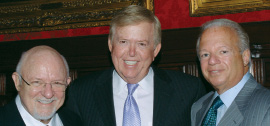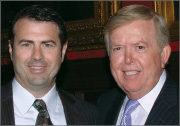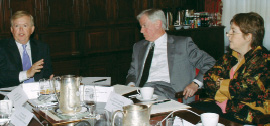- Home
- Media Kit
- Current Issue
- Past Issues
- Ad Specs-Submission
- Ad Print Settings
- Reprints (PDF)
- Photo Specifications (PDF)
- Contact Us

![]()
ONLINE
Confronting the
Aging Crisis in America
America is not prepared for the impending crisis in aging. By 2025, our senior population will double to 78 million, and there is a serious shortage of caregivers, from home-care workers to nurses and geriatricians. In addition, there will be a strain on an already overburdened Medicare system.

Edward J. Rollins, Lou Dobbs, and Frank Corvino
The elderly will inhabit a frightening world in the future, unless legislation is drafted to create a comprehensive long-term senior-care policy that ensures they will have the money to receive continued health care from adequately trained caregivers.
Against the backdrop of our nation’s demographic shift and the shortage of geriatric caregivers, a group of medical experts, caregivers’ organizations, policymakers, and researchers is working to champion efforts that will allow America’s oldest citizens to live their senior years in dignity.

Paul Hogan and Lou Dobbs
The Strategy Forum on Aging was convened by Home Instead Senior Care, the global provider of in-home, nonmedical care for seniors. On June 18, 2010, Forum members gathered at Manhattan’s fabled The Lotos Club for a discussion moderated by nationally syndicated radio host Lou Dobbs who said the crisis of aging in America must be addressed, because it is a personal issue for everyone that is “deeply and profoundly connected to other policy issues.”
The group, chaired by Frank Corvino, CEO of Greenwich Hospital in Greenwich, Connecticut, is endeavoring to raise awareness about and develop solutions for The Crisis of Aging in America and its attendant social, medical, and financial implications.
The focus of the June discussion, the fourth such gathering of the Forum, was to effect change in government policy relating to eldercare.
Participants were Paul Hogan, Co-Founder and Chairman of Home Instead Senior Care; Jim Beck, Director of Public Affairs for Home Instead; Karen Davenport, Director of Health Policy at the Center for American Progress; Dr. Stephen Jones, Director of the Outpatient Center/Center for Healthy Aging at Greenwich Hospital; Nancy E. Lundebjerg, Deputy Executive Vice President and COO at the American Geriatrics Society; John. W. Martin, CEO of the Southeastern Institute of Research and Co-Founder of the Boomer Project; Suzanne Mintz, President and CEO of the National Family Caregivers Association; and CNN commentator, Edward J. Rollins.

Jim Beck
Previous Forum gatherings discussed major issues relating to the aging of America’s population, including the shortage of qualified caregivers; the financial challenges and opportunities connected with the graying of the population; and the need to educate public leaders and citizens about strategies for addressing the challenges.
Eager to move beyond the discussion phase of its work, the Forum is now devising strategies for addressing the aging crisis. First, the group needed to fully understand the problem; now it needs society to realize the magnitude of this issue.
Big changes on the horizon
Outside of medical and senior care communities, the radical change that will begin taking place on January 1, 2011, when the first of the nation’s 78 million Baby Boomers begin to reach age 65, remains something of a secret.
And yet aging is one of the world’s top challenges, Mr. Hogan said.
Mr. Dobbs said, “Mainstream media isn’t focusing on it, yet aging is one of the most dominant issues.”

Karen Davenport
People are living longer as a result of advances in the field of medicine, but longevity carries a steep price in terms of personal and government finances, and the strain on members of the so-called Sandwich Generation, who must care for their parents, often longer than they care for their children.
A demographic perfect storm looms: The burgeoning Baby Boomer population will require care, but Generation Y won’t have an adequate number of caregivers or enough money to handle the job. Gen Y adults will care for their parents longer than they care for their children. In fact, the Sandwich Generation is morphing into a Club Sandwich Generation, with adults caring for their grandparents, parents, and children.
Despite such an enormous crisis on the horizon, few people are prepared for the arrival of the so-called “Age Wave” and its challenges, which include:
• A shortage of geriatricians: 36,000 are needed by 2030, but only 8,000 are expected to study for this specialty
• Too few trained, nonmedical caregivers; 2 million caregivers will be needed by 2017, but only 1.2 million are anticipated to be available
• A need to devise fair labor standards affecting paid caregivers, including home health aides
• A lack of affordable housing for seniors
• Additional strain on the overburdened Medicare system
• A lack of appropriate transportation systems and other community supports that enable seniors to comfortably remain in their homes
• Increasing stress on family caregivers, many of whom face serious financial and emotional issues resulting from their caretaking role
End-of-life issues

Suzanne Mintz
Further exacerbating the crisis will be an anticipated leap in the number of people with Alzheimer’s Disease. Experts say the number of Alzheimer’s patients in the U.S. will swell from 4.5 million in 2000 to an estimated 8.6 million in 2030, and to as many as 16 million in 2050.
Currently, Alzheimer’s is the seventh leading cause of death in the U.S. and the third most expensive condition to treat after heart disease and cancer. Already, more than $150 billion is spent annually to care for Alzheimer’s patients. Alzheimer’s patients must be a major focus of policy affecting senior care, Dr. Jones said.
And while Alzheimer’s patients represent a big proportion of seniors needing care, they are not the whole story.
Providing care and ensuring seniors’ dignity
Senior care philosophy has undergone an enormous shift in recent years. Although care of the elderly was once handled at home or in a nursing home, today, there are numerous services available to boost seniors’ quality of life and ease stress on caregivers.
There is an increased focus on programs and services that allow seniors to “age in place” with dignity, Mr. Hogan said. “This is a tremendous opportunity and responsibility that we have. We need to drive efficiencies.”
“This is an issue of independence for the elderly,” said Mr. Dobbs, adding that it is important that policy discussions include honest dialogue about quality of care and fiscal limitations.

Lou Dobbs, Dr. Stephen Jones, and Nancy E. Lundebjerg
The goal among medical and nonmedical senior caregivers is to facilitate ways seniors can remain in their homes or another place of their choice. Home care, exercise programs, senior day care programs, and preventive medicine are just a few of the services available.
Just as with the aging crisis itself, however, too few people are aware of the resources available to seniors and their families. In addition, most people don’t think to look for this type of aid until a relative experiences a health crisis. The health care reform bill, Mr. Corvino said, “Doesn’t match the magnitude of what we see before us. People are getting old right now.”
Moreover, the need for care is just one piece of the puzzle. Funding that care presents another problem.
Families fail to adequately plan financially for the care of an elderly relative, let alone their own care. In addition, they underestimate the costs involved and cling to an outmoded notion that the government or their children will be able to pay.
The fact is that senior care will be the single largest investment of most people’s lives, more than the cost of a house or a child’s college education.
Average annual out-of-pocket medical costs are $3,851 for ages 65 to 74; $5,066 for ages 75 to 85; and $8,304 for ages 85 and older. The current average annual Social Security benefit totals only $13,863, which leaves little after medical for other needs, and most Americans do not have adequate savings to make up the difference.
Long-term care carries a host of even larger fiscal challenges. Most people who require long-term care need it for an average of five years, and only 20 percent of that care, on average, is provided by paid caregivers, according to Ms. Mintz. Instead, volunteers and relatives pitch in, sometimes giving up jobs and often straining their own finances in the process.
However, despite the enormous financial problems attached to senior care, lack of awareness – about the magnitude of the aging crisis and the need to plan for it long before one reaches retirement age – remains the biggest hurdle society faces.
The Strategy Forum on Aging aims to change that. As Mr. Dobbs said, “It’s important to find some clarity on guiding principles for public policy. We hope to find a way going forward that will focus on efficiency of care.”
Opening the dialogue
The Forum was created “because providers and stakeholders in aging and eldercare never talk to each other,” Mr. Hogan said. This group “can uncover some solid ideas,” he said.
Mr. Corvino is hopeful that the Forum “can make some real changes happen” in the realm of senior care. “We’ve got to make the public aware of the issue.”
Getting the aging crisis on lawmakers’ radar is foremost among the Forum’s priorities. The subject has been repeatedly set aside while Congress has focused on other serious matters. Even the recent health care reform debates failed to target issues of senior care, focusing instead on reform of health care financing.
“We need to go beyond just discussing it and take steps to influence policy,” Mr. Beck said.
Determining how to focus attention on the aging crisis remains a quandary. In addition to reluctance on the part of individuals to discuss the issue, experts on aging must overcome national fatigue resulting from the health care reform debates and economic factors that are forcing taxpayers to watch every penny.
A few initiatives under consideration, such as quality care Medicare bonuses for geriatricians who offer better care than their colleagues, will address some of the problem in the long term, Ms. Lundebjerg said. However, the time to act is now, the Forum’s participants agree. Waiting for long-term programs to take root will not help the immediate problem; the population is already aging.
Getting the word out
Raising awareness about the crisis of aging in America must be the first step in addressing the issue, the Forum’s members said.
One priority is to initiate a dialogue with lawmakers and other authorities that can result in effective policy changes. The Forum also plans to identify alliances with agencies and nonprofit groups focused on the care of seniors. In addition, it is looking to launch a far-reaching national public service campaign highlighting the crisis, the need for families to plan for the care of a loved one, and the resources available to seniors and their families.
Guided by some suggested principles, the Forum plans to develop a Policy Statement to advance the public dialogue. The goal is to develop a policy that:
• Reduces and/or manages the overall cost of long-term care for seniors – to families and to government
• Improves care and senior satisfaction with care and care options
• Optimizes the current care continuum – ensuring that the most appropriate care options are employed at the right times
• Encourages home- and community-based care
• Encourages innovation in care
• Ensures that adequate caregivers are available across the care continuum, from home care workers to geriatricians
• Seeks an appropriate blend of medical care for seniors (health care) and long-term care
• Applies an appropriate labor policy that supports the need for long-term care
Effecting policy change won’t happen overnight, of course, but the Forum on Aging is committed to making it happen. The key, Forum members agree, is getting the word out. The group is certain that policy changes will naturally follow widespread understanding of the crisis.
After all, everyone can relate to needing to care for an elderly parent, and the inevitability of one’s own sunset years. Still, it will be difficult to create momentum around an issue that most people decline to talk about, Ms. Davenport acknowledged.
Yet, the Forum’s members are convinced that people from all walks of life must be encouraged to consider the overall issue and the many consequences of failing to address its attendant problems.
The dearth of physicians specializing in geriatric care, a lack of proper training and competitive pay for home health aides, and the need for responsible financial planning by families will have serious implications for every American navigating the golden years.
As Dr. Jones put it, “We need to get out in front of the wave.”•